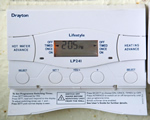The central heating programmer/timer
This allows you to set times for your heating to automatically switch on and off to suit your lifestyle. There’s generally two types of timer, a manual clock with tabs to set the heating times and an electronic one.
Make sure the timer is set to the correct time of day. If you have a combination (combi) boiler then you’ll only set the heating periods for the radiators, as hot water is heated instantly when the hot water taps are opened.
Setting the timer
What times should I set my timer to go on and off?
It’s best to set your heating to switch on about half an hour before you want your home to be warm (usually when you wake up) and to go off about half an hour before you go out or go to bed. Ideally you should run the system in two periods, and for no more than nine hours total in a day.
What does each type of timer control?
The pictures below show what typical manual programmers/timers might look like.

Manual programmer/timer for a combi boiler – times the radiator heating only.

Manual programmer/timer for a non-combi boiler – times the radiator and hot water heating.

Digital programmer/timer for a non-combi boiler – times the radiator and hot water heating.
Setting the thermostats
How do room thermostats work?
It controls the temperature of your whole home based on the temperature of the air circulating around the home. When the air around it is warm enough, the thermostat sends a signal to the central heating pump and boiler to stop heating your radiators. They’re usually found in the living room, hallway or dining room.
What temperature should I set my room thermostat to?
Typically a temperature between 18°- 21°C (66°- 70°F) is recommended. If you're older, or unwell, then you may want set it a bit higher at 21°- 23°C (70°- 73°F).
Boiler thermostat
This is a control found on the boiler itself.
It controls the temperature of the hot water flowing around the pipes to the radiators.
How should I set my boiler thermostat?
The boiler thermostat could be rated differently from one boiler to another. The boiler will operate most efficiently on the max/high setting. It should be set on high/5 in winter and low/1 in summer.
Thermostatic radiator valves (TRVs)
When the air around your room thermostat cools the thermostat sends another signal to the central heating pump and boiler to start heating up water again to pump around your pipes to your radiators. Your radiators will then warm up again. Throughout the day your radiators will feel cooler and warmer to keep the temperature constant.
Check that the thermostatic valves on the radiators and time clock are set at the desired temperature and time. It's best to set your TRV to a middle setting and see if the room is warm enough. If the room is too warm, turn the TRV down by 1, if the room is too cold, turn the TRV up by 1. A middle setting corresponds to approximately 20°C (68°F). Do not turn the TRV fully on or fully off to make the room you are in warmer or cooler - this will waste fuel. Turn it a little way and let it do the work.
The electricity pump
This is generally located near the time clock and it must be switched on in order for water to be circulated to the radiators.
Hot water tank
How can I insulate my hot water tank?
You can buy a jacket for your hot water tank from your local DIY store. This is one of the simplest and cheapest things you can do to cut your fuel bills and save energy. Some cylinders already have foam sprayed on them don’t need a jacket. It’s also worth insulating the pipes that enter and leave the tank, you can get foam tubes to do this.
What controls the temperature of my hot water?
Hot water storage tanks are usually fitted with a thermostat to control the water temperature. For water that’s heated by an electric immersion, the thermostat is inside the tank. If you heat your water with a combination (combi) boiler, the water heating control is on the boiler.
At what temperature should the tanks thermostat be set?
The temperature you set determines the temperature of the hot water coming out of the hot water taps. Ideally, it should be set to 60°C and definitely no lower than 55°C (as this could cause legionnaires disease).
New tenants
If you’ve recently moved into council housing, the instructions for how to operate the heating system may not be available. One of our gas contractors will explain the controls to you during the gas safety check, if necessary.
If you’re struggling to understand your system and you have no neighbours with similar systems to ask, you can contact your local housing office. They can arrange for someone to call and explain it again to you.
